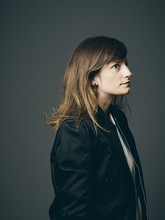Depuis les profondeurs de la grotte jusqu'à celle de notre cerveau, Hyperphantasia crée un espace de rencontre de 36 000 ans de technologies d'images, à la recherche de l'origine des images.
Au paléolithique, on plongeait dans les profondeurs et l'obscurité de la caverne, avec ce désir pour l'humain d'y inscrire une œuvre de l'esprit sur les parois des grottes.
En 2022, les sciences computationnelles nous permettent d'analyser de grandes quantités de données et de générer des prédictions.
À partir d'une base de données scientifique de la grotte Chauvet-Pont-d'Arc, un réseau de neurones artificiels a été entraîné afin de fabriquer de nouvelles images de la préhistoire pour la création de l'œuvre. Une paroi vidéographique s'anime lentement, laissant entrevoir une « nouvelle » préhistoire, des imaginaires parallèles de nos ancêtres. En 2021, une mission du CNES et de l'ESA a étudié l'évolution du sommeil dans l'espace. Des données encéphalographiques enregistrées sur plusieurs nuits ont permis à l'artiste de travailler à partir de signaux de rêves de l'espace.
Ces signaux du plus profond de notre inconscient sont incarnés dans des architectures de rêves en impression 3D. Un paysage issu des images mentales apparaît dans la lumière de la vidéo.
Depuis la génération de nouvelles images inédites de la préhistoire par un modèle de machine learning jusqu'à l'extrusion de sculptures de rêves de l'espace, on suit la naissance de nouvelles images des profondeurs de nos imaginaires qui vont fusionner et se synchroniser.
Cette œuvre est réalisée dans le cadre de la résidence hors les murs de l'Observatoire de l'espace, le laboratoire culturel du CNES (Centre national d'études spatiales).
Le Fresnoy et Alain Fleischer, Eric Prigent, Luc-Jérôme Bailleul, Stéphanie Robin, Pascale Pronnier, Marie Lavandier et toute l'équipe du Fresnoy
Le Cnes et Gérard Azoulay, Francis Baros, Perrine Gamot, Tristan Hermel, Rachel Debs, Denis Baron, Marie Fesuick
L'ESA (Agence spatiale européenne)
La DRAC Auvergne Rhônes-Alpes et la conservation de la grotte Chauvet-Pont d'Arc, Marc Drouet, Marie Bardisa, Charles Chauveau et Marie-Blanche Potte
Le Centre national de Préhistoire et Geneviève Pinçon
Lascaux IV pour son soutien au premier prototype de l'œuvre (2019)
Dreem et Maya Dorsey, Eden Debellemaniere
Carine Karachi et l'institut du Cerveau, Pitié-Salpétrière
Scaleway et Arnaud De Bermingham, Philippe Dol et Mélodie Morice
Robot Faber / Christophe Grégorio / Poliarts, Samuele Sodini / Orange Apps Gmh, Christian Mayer
Ainsi que Jean-Michel Geneste, Sofian Audry, Yves Coppens, Hilaire Multon et Teeradon Thongsaard
Le Ministère de la Culture pour la mise à disposition gracieuse de données qui ont servi à la réalisation de l'œuvre [Ressources numériques : Ministère de la Culture, 2016, conservées au Centre national de Préhistoire]

Justine Emard vit et travaille à Paris.
Ses œuvres explorent les nouvelles relations qui s’instaurent entre nos existences et la technologie.
En associant les différents médiums de l’image – de la photographie à la vidéo et à la réalité virtuelle — elle situe son travail au croisement entre les neurosciences, les objets, la vie organique et l’intelligence artificielle. Ses dispositifs prennent pour point de départ des expériences de deep-learning (apprentissage profond) et de dialogue entre l’humain et la machine. Depuis 2016, elle collabore avec des laboratoires scientifiques au Japon. En 2017, elle a été lauréate de la résidence hors-les-murs de l’Institut français à Tokyo.
Son travail a été exposé dans des musées tels que le NRW Forum (Düsseldorf), le National Museum of Singapore, le Moscow Museum of Modern Art, l’institut Itaú Cultural (São Paulo), la Cinémathèque québécoise (Montréal), le Irish Museum of Modern Art (Dublin), le Mori Art Museum (Tokyo), le MOT Museum of Contemporary Art Tokyo, le Barbican Center (Londres), le World Museum (Liverpool), la Fondation Pernod Ricard (Paris), le CNES – Centre national d’études spatiales (Paris), le musée du Louvre-Lens et le ZKM, Centre d’art et des médias (Karlsruhe). Elle participe à des biennales internationales comme la Biennale internationale d’art contemporain de Moscou (Russie), la Triennale de Tongyong (Corée du Sud), la Biennale de Karachi (Pakistan) et la Biennale de Chengdu (Chine). Ses œuvres font partie de collections nationales et internationales.
En 2020, elle a été lauréate de la commande nationale photographique "Image 3.0" du Centre national des arts plastiques (CNAP) en partenariat avec le Jeu de Paume à Paris. En 2021-2022, puis en 2023-2024, elle a été artiste-professeure invitée au Fresnoy - Studio national des arts contemporains. En 2023, elle a été lauréate de la distinction « 100 femmes de culture » en France. Justine Emard est directrice artistique de l'exposition permanente du pavillon de la France pour la prochaine exposition universelle à Osaka en 2025.
Programmation et développement : Martial Geoffre Rouland, Jérémy Lesage, Ludovic Mallegol, Nicolas Marichez et Yassin Siouda
Sound design : Antoine Bertin
Enregistrement du bruit des neurones : Justine Emard
Production : Katell Paillard


